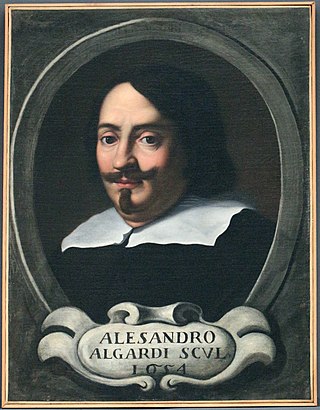
Alessandro Algardi was an Italian high-Baroque sculptor active almost exclusively in Rome. In the latter decades of his life, he was, along with Francesco Borromini and Pietro da Cortona, one of the major rivals of Gian Lorenzo Bernini, in Rome. He is now most admired for his portrait busts that have great vivacity and dignity.
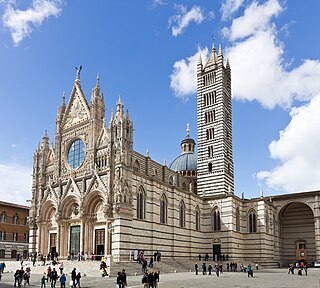
Siena Cathedral is a medieval church in Siena, Italy, dedicated from its earliest days as a Roman Catholic Marian church, and now dedicated to the Assumption of Mary.

Eleonora Gonzaga, was born a princess of Mantua as a member of the House of Gonzaga, and by marriage to Ferdinand II, Holy Roman Emperor, was Holy Roman Empress, German Queen, Queen of Hungary and Bohemia.

Pietra dura or pietre dure, called parchin kari or parchinkari in the Indian Subcontinent, is a term for the inlay technique of using cut and fitted, highly polished colored stones to create images. It is considered a decorative art. The stonework, after the work is assembled loosely, is glued stone-by-stone to a substrate after having previously been "sliced and cut in different shape sections; and then assembled together so precisely that the contact between each section was practically invisible". Stability was achieved by grooving the undersides of the stones so that they interlocked, rather like a jigsaw puzzle, with everything held tautly in place by an encircling 'frame'. Many different colored stones, particularly marbles, were used, along with semiprecious, and even precious stones. It first appeared in Rome in the 16th century, reaching its full maturity in Florence. Pietra dura items are generally crafted on green, white or black marble base stones. Typically, the resulting panel is completely flat, but some examples where the image is in low relief were made, taking the work more into the area of hardstone carving.
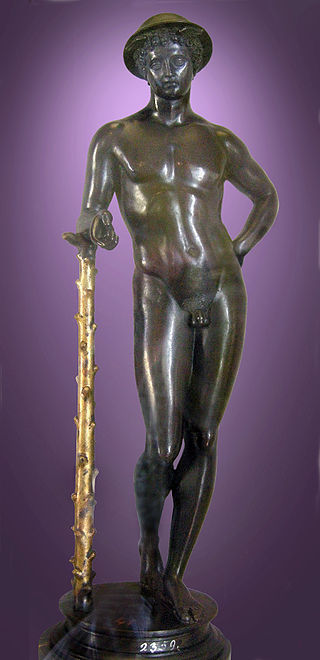
Pier Jacopo Alari Bonacolsi, called L'Antico by his contemporaries, and often Antico in English, the nickname given for the refined interpretation of the Antique they recognized in his work, was a 15th- and 16th-century Italian Renaissance sculptor, known for his finely detailed small bronzes all'Antica—coolly classicizing, often with gilded details, and silver-inlaid eyes, a refinement that is found in some classical and Hellenistic Greek bronzes.

The Certosa di Pavia is a monastery and complex in Lombardy, Northern Italy, situated near a small town of the same name in the Province of Pavia, 8 km (5.0 mi) north of Pavia. Built in 1396–1495, it was once located on the border of a large hunting park belonging to the Visconti family of Milan, of which today only scattered parts remain. It is one of the largest monasteries in Italy.
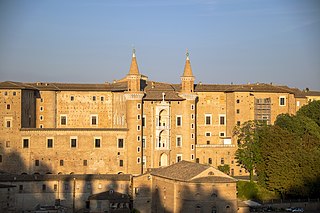
The Ducal Palace is a Renaissance building in the Italian city of Urbino in the Marche. One of the most important monuments in Italy, it is listed as UNESCO World Heritage Site since 1998.

The Palazzo Ducale di Mantova is a group of buildings in Mantua, Lombardy, northern Italy, built between the 14th and the 17th century mainly by the noble family of Gonzaga as their royal residence in the capital of their Duchy. The buildings are connected by corridors and galleries and are enriched by inner courts and wide gardens. The complex includes some 500 rooms and occupies an area of c. 34,000 m2, which make it the sixth largest palace in Europe after the palaces of the Vatican, the Louvre Palace, the Palace of Versailles, the Royal Palace of Caserta and the Castle of Fontainebleau. It has more than 500 rooms and contains seven gardens and eight courtyards. Although most famous for Mantegna's frescos in the Camera degli Sposi, they have many other very significant architectural and painted elements.

Giuliano da Maiano (1432–1490) was an Italian architect, intarsia-worker, and sculptor, the elder brother of Benedetto da Maiano, with whom he often collaborated.

Giovanni CristoforoRomano (1456–1512) was an Italian Renaissance sculptor and medallist.

Inlay covers a range of techniques in sculpture and the decorative arts for inserting pieces of contrasting, often colored materials into depressions in a base object to form ornament or pictures that normally are flush with the matrix. A great range of materials have been used both for the base or matrix and for the inlays inserted into it. Inlay is commonly used in the production of decorative furniture, where pieces of colored wood, precious metals or even diamonds are inserted into the surface of the carcass using various matrices including clear coats and varnishes. Lutherie inlays are frequently used as decoration and marking on musical instruments, particularly the smaller strings.

The Camera degli Sposi, sometimes known as the Camera picta, is a room frescoed with illusionistic paintings by Andrea Mantegna in the Ducal Palace, Mantua, Italy. During the fifteenth century when the Camera degli Sposi was painted, Mantua was ruled by the Gonzaga, who maintained Mantua's political autonomy from its much stronger neighbors Milan and Venice by bidding their support out as a mercenary state. By commissioning Mantegna to paint the chamber, Ludovico III Gonzaga, the Marquis of Mantua, sought to give the Gonzaga rule more cultural credibility at a time when other Northern Italian courts such as the Ferrara were commissioning their own “painted chambers”.

The Chapel of the Holy Shroud is a Baroque-style Roman Catholic chapel in Turin in northern Italy, constructed to house the Shroud of Turin, a religious relic believed to be the burial shroud of Jesus of Nazareth. It is located adjacent the Turin Cathedral and connected to the Royal Palace of Turin. The chapel was designed by architect-priest and mathematician Guarino Guarini and built at the end of the 17th century (1668–1694), during the reign of Charles Emmanuel II, Duke of Savoy, and is considered one of the masterpieces of Baroque architecture. Heavily damaged in a fire in 1997, it underwent a complex 21 year restoration project, and reopened in 2018. The chapel has an intricate and self-supporting wooden and marble dome.
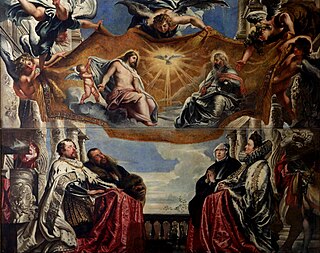
The Gonzaga Family in Adoration of the Holy Trinity is a painting by the Flemish artist Peter Paul Rubens, housed in the Ducal Palace in Mantua, Italy. The work was commissioned by Duke Vincenzo I Gonzaga for the Jesuit church in Mantua, while Rubens was his court painter.

The Parnassus is a painting by the Italian Renaissance painter Andrea Mantegna, executed in 1497. It is housed in the Musée du Louvre of Paris.

La Scapigliata is an unfinished painting generally attributed to the Italian High Renaissance artist Leonardo da Vinci, and dated c. 1506–1508. Painted in oil, umber, and white lead pigments on a small poplar wood panel, its attribution remains controversial, with several experts attributing the work to a pupil of Leonardo. The painting has been admired for its captivating beauty, mysterious demeanor, and mastery of sfumato.

Frans Geffels, known in Italy as Francesco Geffels, was a Flemish painter, printmaker, architect, stage designer and designer of ephemeral structures for solemn and festive occasions. After training in his native Antwerp, he was mainly active in Mantua, where he was prefetto delle fabbriche to the Duke, a role that gave him the direction of the artistic and construction activities undertaken by the Ducal court. He worked also on projects for the local aristocratic class of Mantua. In addition, he completed projects for the Liechtenstein princes and for the imperial court in Vienna.
The Studiolo of Isabella d'Este was a special private study, first in castello di San Giorgio, later the Studiolo was moved to the Corte Vecchi apartments in the Ducal Palace in Mantua, designed by, and with a collection of art specially commissioned by Isabella d'Este.
Gian Battista Covo or Battista da Covo was an Italian architect. From 1513 until 1524 he was "Prefect of the Gonzaga Buildings" under Francesco II Gonzaga. He designed the second phase of the Studiolo of Isabella d'Este on the ground floor of the "Corte Vecchia" of the Ducal Palace. In 1524 he started collaborating with Giulio Romano, who that year took over as prefect.

Margherita Malatesta of the House of Malatesta was the wife of Francesco I Gonzaga of the powerful House of Gonzaga, the ruler of Mantua in the north of the Italian peninsula, whom she married in 1393. She acted as regent during the absence of her spouse in 1398-1399.


















